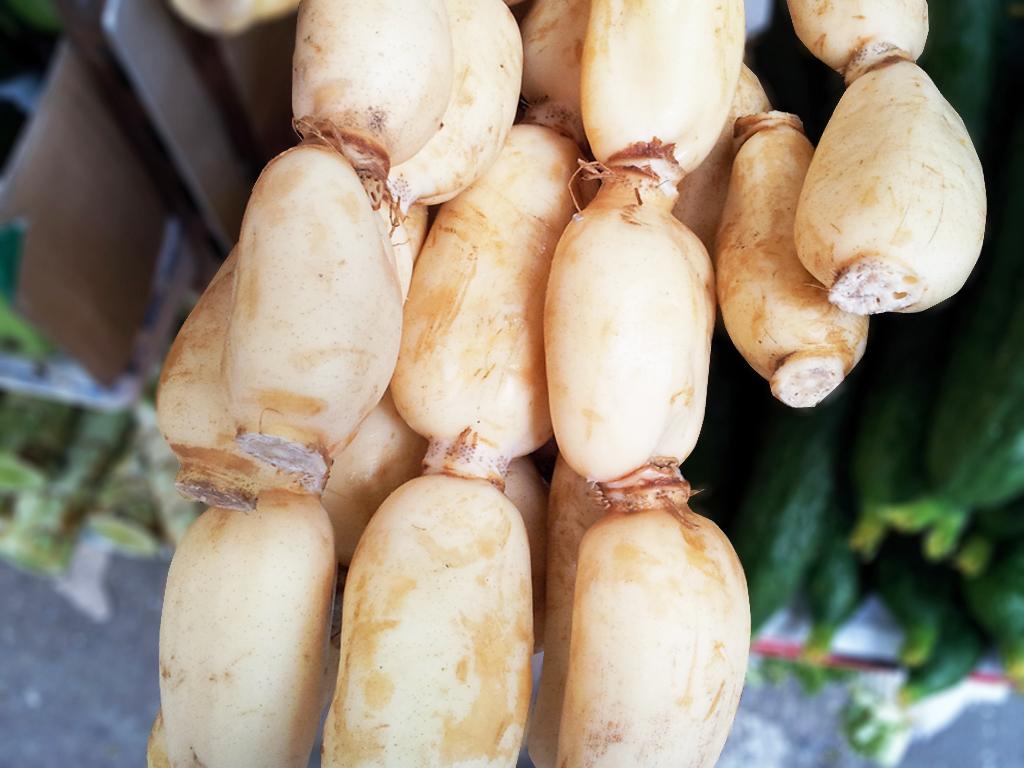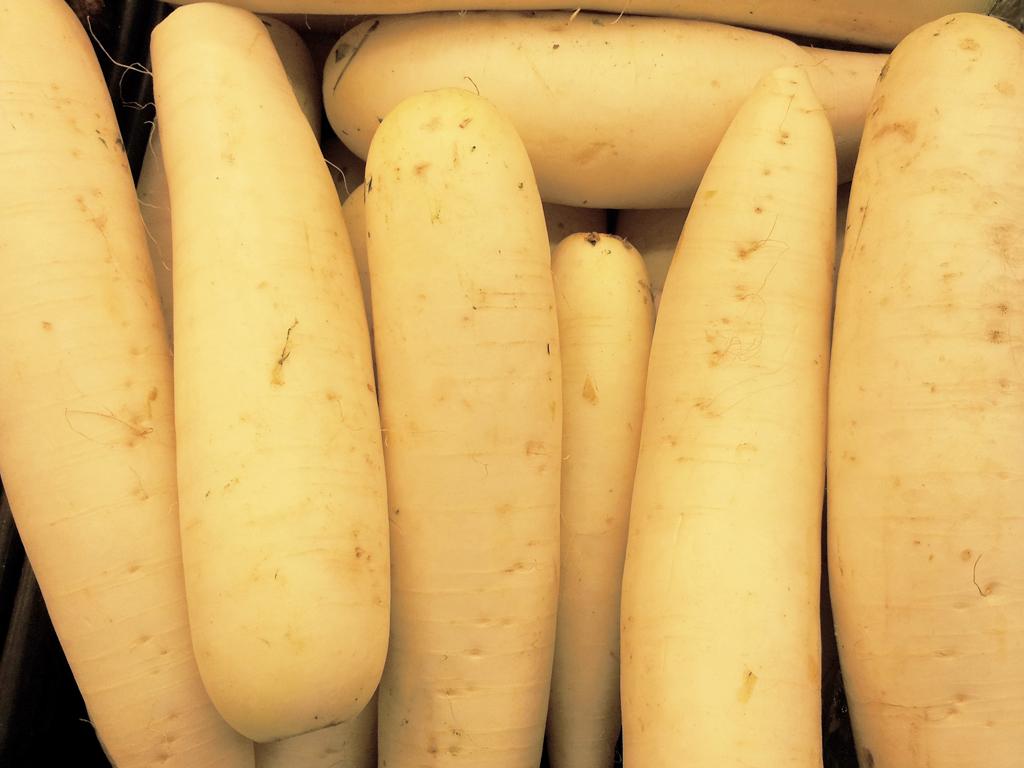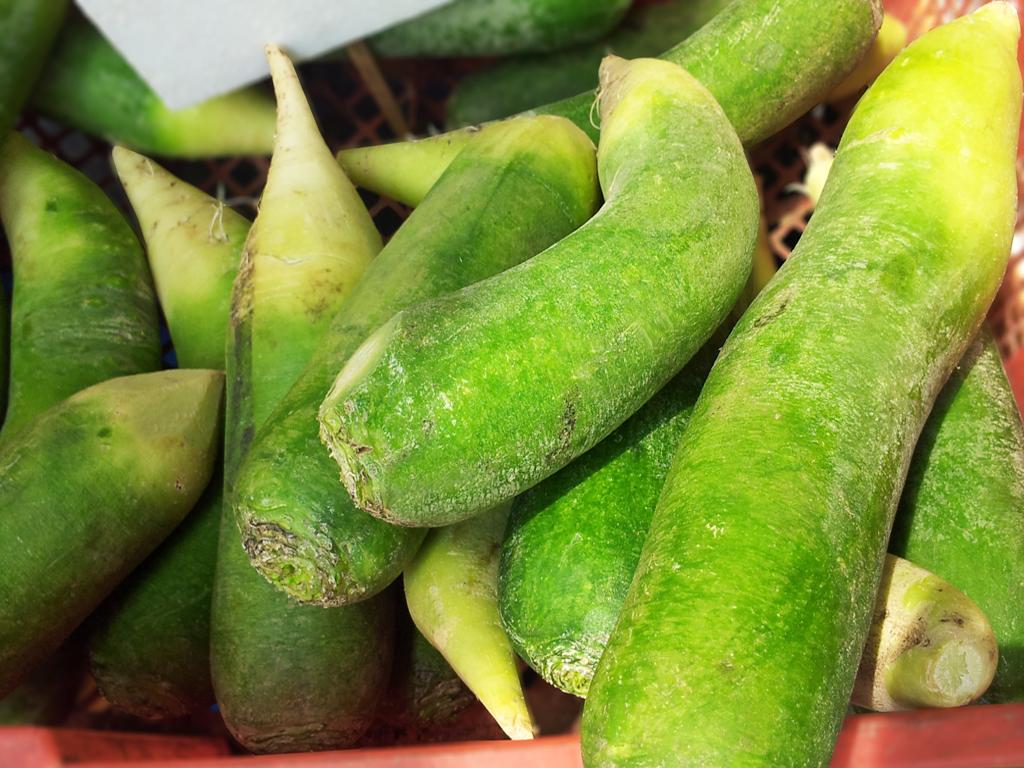7 Mins Read
Missing the dozens of varieties of potatoes you used for your spud-tastic recipes back home? Why not give these Asian starch stars below a try? They make great and nutritious substitutes for the ol’ spud and with our guide, using them at home is easy!
Lotus Root – Lin Ngau
This yellowish white root with a doily-like cutout shape is sweet and light, ideal for the summer. Don’t worry if you find yourself with thin threads coming detached when you chop or eat them, this is perfectly normal. With its fresh and mild sweet flavour, Lin Ngau has a rather hard texture so Cantonese people usually use softening cooking techniques like steaming and boiling.
High Season: April – August
How To Eat: Wash and peel off the skin. Discard the joints as they are too hard and rough for eating. Slice it thinly and deep fry (or shallow fry) to make crispy lotus root chips – all the rage at the trendiest restaurants these days. Mashed lotus root also makes a great filler for vegan/vegetarian patties/burgers. Just steam, mash with a fork and mix with whatever other fillings you like (a medley of crunch carrots, onions and some chopped parsley perhaps) and then pan fry. Did you know? Lotus seed paste is the traditional filling for the Mid-Autumn Festival mooncake.
What To Look For: Avoid the wet, damp ones that have too much mud covering them- excess moisture can lead to them rotting faster. Choose the clean, non-muddy, dry ones.
Storage: Those that are not cut can last for about 5 days in the fridge. If they are cut, make sure you wrap your piece with newspaper/gladwrap before putting it in the fridge and eat it as soon as possible.
Taro Root – Wu Tau
Taro’s brown and muddy appearance does not exactly appealing scream ‘eat me’ but cut it in half and you will find a beautiful starchy white root textured with purple flecks. Raw Wu Tau has a firm texture but it becomes creamy and smooth after cooking- its starch content if very high. Cantonese people love its sweetness and creaminess and it is consumed often as a way to stay warm in the colder months.
High Season: October – December
How To Eat: Wu Tau should be eaten peeled. It is a versatile root- its sweetness makes it ideal for dessert like drinks and dishes- Taro pie, Taro Bubble Tea, Taro pudding- all are common across town. Taro works great pureed and baked in desserts but our favourite recommendation is taro fries- slice in sticks and bake in the oven for a delicious alternative to the potato kind..
What To Look For: Choose the dry heavier ones as they have the highest water content. Make sure the skin is not damaged. If you buy very wet roots, they are more perishable.
Storage: As long as the root remains dry and uncut, it can last for up to two weeks away from sunlight. However, if it is wet or cut, eat it as soon as possible.
 Bamboo Shoots – Zuk Seon
Bamboo Shoots – Zuk Seon
Bamboo shoots are the young fresh shoots of the bamboo plant. They are yellowish-brown in color. You can buy them fresh enveloped in their outer skin/husk or in ready cut in cans. They are crunchy, crisp and a little salty and are a great addition to any stir fry. The Cantonese usually eat them chopped up in stir fry dishes with poultry or pork- the beloved Minced Pigeon with Lettuce is popular on Chinese restaurant menus the world over. They can be eaten all year round but the winter shoots are the most prized. They are mild in taste though to some, they are similar to globe artichokes.
High Season: October – December.
How To Eat: Peel the brown skin. Chopped and sauteed/stir fried, they are an ideal way to add crunch to any dish. Sautée chopped bamboo shoots, chopped shitake mushrooms and pine nuts with a meat of your choice and wrap with lettuce for your version of the Cantonese favorite. Bamboo shoots also make great pickles thanks to their crunchiness. Never eat bamboo shoots raw as they contain toxins that are destroyed by heat.
What To Look For: Choose the tightly wrapped/packed ones. Those whose outer skin layer are loose are older.
Storage: Don’t peel the shoots until you are ready to eat them, . Keep them in the shade and consume within a week
White Radish/Daikon – Baak Lo Baak
Long, lean and almost translucently white, the daikon radish is a staple in the Cantonese diet (as well as the Japanese diet). To some, it taste sweet, to others slightly bitter and to many others, it tastes of nothing much at all. Compared to European radishes which have a peppery bite, the daikon is much milder. Baak Lo Baak is the star ingredient in White Radish Rice Cake, one of the most important dishes consumed during the Chinese Lunar New Year.
High Season: September – December
How To Eat: Peel and wash before consuming. Daikon can be eaten raw and makes a great crudite vegetable when accompanied by a dip. Also great instead of carrots in slaws when you julienne them and ideal for pickles. Did you know? While usually grouped with root vegetables, radishes are actually part of the Brassica family (that’s right- they are related to cabbage and brocoli!).
What To Look For: Pick the ones that are firm, clean, as white in color as possible and unblemished- and ideally have some of their green tops still attached.
Storage: Store in newspaper/gladwrap in the fridge, where they will last up to a week.
Green Radish – Ceng Lo Baak
Not as commonly found and not as commonly eaten, Ceng Lo Baak is a sweeter, green version of its white cousin. It is a key ingredient in the Green and Red Radish Soup with Pork, one of the most iconic Cantonese soups, eaten in the Autumn to ease the dryness of the weather.
High Season: May – October
How To Eat: Peel and wash before usage. Green radishes can be used in the same way as white radishes- as they are sweeter than the white variety, they work especially well for pickling especially when paired with spices and chillies. In India, the Punjabis make curry with it.
What To Look For: Choose those with bright green skin- avoid the ones with too many twists and ridges.
Storage: Cut the head and the end of it before storing in the fridge. It can last for about a week.
 Chinese Carrot – Hung Lo Baak
Chinese Carrot – Hung Lo Baak
The Chinese carrot is much thicker and rougher than Western carrots. It has a sweeter taste and a softer texture.
High Season: December – April
How To Eat: Peel the skin and wash. You can use it as you would any other carrot! Great for juicing/smoothies as you can get quite a bang for your buck.
What To Look For: Don’t worry if you find them covered with dry mud, that’s totally normal. Check the color of the top part/head- the brighter, the sweeter, the browner, the less fresh.
Storage: Store in a cool, dry place and they can last for up to 10 days.
Jicama/Yam Bean/Mexican Potato – Saa Got
Originally from Central America, the Saa Got is now popular all across China. The root has thin, brown skin and its flesh is cream colored, crunchy with s a slightly nutty flavor.
High Season: All year round
How To Eat: Make sure to peel before eating. Jicama can be eaten raw or cooked- it is well known in the raw food community as a replacement for rice in raw “sushi.” Otherwise, use it exactly as you would potatoes.
What To Look For: Choose firm, non blemished ones with a shine to them,
Storage: Keep in a cool dry place for up to two weeks.
Join us next week for the Wet Market Series Part 4 where we explore the world of Chinese dried herbs and spices. Or try the previous entries in this series:
Green Queen Living: Wet Market Series Part 2 – Guide to Chinese Melon & Gourds (Gwaa)
Green Queen Living: Wet Market Series Part 1 – Guide to Chinese Leafy Greens (Choy)
All images courtesy of Green Queen.




 Bamboo Shoots – Zuk Seon
Bamboo Shoots – Zuk Seon

 Chinese Carrot – Hung Lo Baak
Chinese Carrot – Hung Lo Baak 


